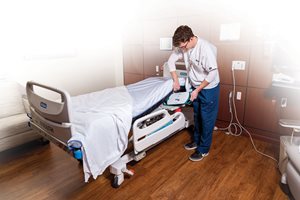Patient Monitoring Technology Reduces Code Blue Emergencies at LMH
 Informational Video About EarlySense Available at https://youtu.be/yTNB003onuQ
Informational Video About EarlySense Available at https://youtu.be/yTNB003onuQ
In pursuit of its mission to improve the health of the community, Licking Memorial Hospital (LMH) continually evaluates new clinical technologies and their potential to positively affect patient outcomes. Among the systems and tools that have recently been adopted, the EarlySense patient monitoring system has played a crucial role in optimizing patient care and safety. Since its implementation in 2016, EarlySense has helped to dramatically reduce the number of code blue emergencies reported at LMH.
A code blue is activated at LMH when a healthcare provider believes the life of an adult patient is in immediate and severe danger. The medical emergency is announced over the public address system so that a team of responders can assist in providing life-saving care. A code blue can be called for a variety of conditions including cardiac or respiratory arrest, heart arrhythmias, or a sudden drop in blood pressure.
Prior to a code blue alert, the decline of a patient’s health often is subtle and asymptomatic. However, EarlySense assists in the early detection and prevention of potential adverse events by providing continuous, contact-free monitoring from a device under the mattress. Utilizing a patented sensor and advanced algorithms, EarlySense detects movement in the bed to assist with reminding staff when patients need to be turned to prevent skin breakdown, delivers vital signs – including cardiac and respiratory activity, and analyzes trends that alert LMH clinical staff of possible patient deterioration so that they can intervene in a timely manner.
Before the implementation of EarlySense in March 2016, LMH had experienced 31 code blue events in 2015. Only five code blues were initiated through the first three quarters of 2019, which marks an 85-percent reduction in yearly medical emergencies since the technology was installed. Conditions that have been proactively treated, thanks in part to EarlySense, include sepsis, respiratory depression (low respiratory rate), tachycardia (abnormally fast resting heart rate), bradycardia (abnormally low resting heart rate) and tachypnea (abnormally rapid breathing).
EarlySense also is a crucial component of LMHS’ sepsis reduction campaign. Sepsis, the body’s overwhelming and life-threatening response to infection, is responsible for more than 250,000 deaths annually nationwide. In 2015, the mortality rate for sepsis at LMH was 27.1 percent – above the statewide average of 19.4 percent. By leveraging the data from EarlySense and a patient’s electronic health record, LMH created a visual smart board that constantly monitors for signs of sepsis. Within one year, the number of sepsis-related deaths at LMH declined nearly 70 percent to 8.9 percent. The morality rate has remained below 9 percent in the years since, and an estimated 177 lives have been saved.
When LMH began using EarlySense in 2016, it was the first hospital in Ohio to utilize the innovative technology. LMH also was at the forefront nationally as one of the first 13 facilities in the United States to adopt EarlySense patient monitoring. An informational video about EarlySense is available at https://youtu.be/yTNB003onuQ.